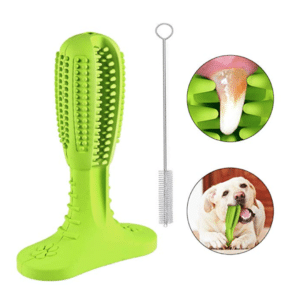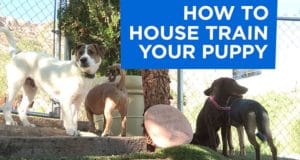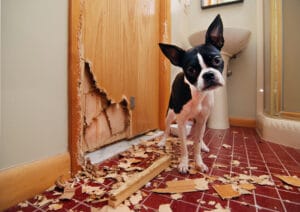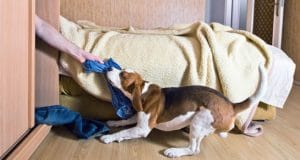Have you been asking the question, “How do you stop a puppy from biting?” While puppy biting is a completely natural behavior during the puppy stage, it is also important to let your pup know what is and isn’t allowed to be chewed on.
Puppies begin biting very early on in life. Just like human babies, it is common for them to chew on objects during the teething stage to reduce discomfort. Furthermore, many dogs prefer using their mouths rather than their paws for manipulating objects. Once again, this behavior begins in puppyhood as young pooches start to explore their world.
Puppy biting may be cute at the beginning, but as your pup grows, these little nips can turn into painful bites. A puppy’s teeth are very sharp, and dogs often don’t know how hard they’re biting. Thus, the puppy-raising experience will generally include that one moment when Fido playfully bites down on a finger and draws blood.
Needless to say, this is not a behavior we humans want to have continue, especially not into adulthood. Want to learn how to get a puppy to stop biting? Here are the steps to take to stop puppy nipping.
Inhibit the Biting
The first step for how to get your puppy to stop biting is to inhibit the behavior. It is totally normal for puppies to mouth each other when they play. This mouthing, however, can quickly turn into a bite. When it does, the puppy on the receiving end will yelp, and this sound startles the puppy doing the biting, thus making him release.
Humans can exploit this behavior to stop puppy nipping and teach your pup how much mouthing is acceptable. When a puppy latches onto your hand or finger too hard, let your hand go limp and imitate that yelping sound. When the puppy releases, ignore her for 10 to 20 seconds and then resume play.
It’s important to remember, though, not to pull away from the bite. This can trigger your puppy’s chase instinct and make the problem worse. If the yelp doesn’t work or you’d prefer not to make that sound, you can substitute a loud “Ow!” or use other verbal deterrents.
Don’t repeat the limp and yelp process more than three times in 15 minutes. If you come to this point, it’s time for a puppy timeout.
The goal here is to teach the puppy that gentle play continues and rough play stops. Once you’ve inhibited the hard bites, repeat this teaching process with more moderate bites. Eventually, you should be able to teach her that mouthing without biting down is OK but that anything more than that is not.
Redirect
If you’d like to teach your puppy that her mouth on human skin is not acceptable at all, you’ll most likely want to use the redirection method. For this method on how to make a puppy stop biting, each time the puppy tries to mouth you, pull your hand away before contact and promptly provide a treat or wave around a chewy toy for him to bite on instead.
You can also satisfy your puppy’s urge to mouth things with noncontact games such as fetch or tug-of-war. Keep in mind, however, to never let the tugging become too aggressive. You’ll want to teach your puppy the commands “let go” or “leave it” so that you can always remove something from his mouth without the response of aggressive puppy biting.
Distraction
In addition to mouthing people, puppies will also mouth things in their environment. This is mostly done out of curiosity. There are many ways to teach your dog not to chew on house furnishings. Besides puppy-proofing your home, be sure to provide an assortment of interesting and safe chew toys for your pup to play with. These toys should be chosen for your puppy’s level of chewing and destructiveness. For example, if she shreds a plush toy in 2 minutes, you may want to stick toys made of rubber or hard plastic.
Hide-the-treat toys are also great for distracting puppies from nibbling on other things. This type of toy not only distracts your pup but also provides mental stimulation as she tries to figure out how to get to the reward.
A final option for distracting your pup is to arrange a playtime for your dog with other puppies or vaccinated adult dogs. Not only will this help to socialize her with other dogs, but those dogs will also assist in the process of teaching your puppy when a bite is too hard.
Deterrence
There are various products designed to prevent a dog from licking or chewing objects in the house. These products include Bitter Apple, Bitter Cherry and YUCK No Chew Spray. As you have probably guessed, these products will put an unpleasant taste in your puppy’s mouth each time she chews on furniture or other objects in the house. With that being said, this method of stopping puppy biting is not as simple as spraying your belongings with these products. There are two very important steps involved in using them for training.
The first step is to associate the smell and taste in your dog’s mind so that the scent alone will keep him away from unacceptable chewing targets. To do this, put a little bit of the product on a tissue or cotton ball and gently put it in your puppy’s mouth. He should spit it out right away. After he spits it out, let him smell it so that he makes the association.
The second step comes in handy when you’re actively using the product for training. For the second step to work, make sure your dog doesn’t have access to water for up to an hour (but no longer) after contact with the product. This may sound cruel, but if your dog learns that he can just run to his bowl and get rid of the taste, the deterrent will become ineffective.
During the training process, place the product once a day on any objects you don’t want him to lick or chew. Continue doing this for the next two to four weeks until your puppy has stopped chewing your belongings.
Ankle Biters
Puppy biting doesn’t always happen during playtime. Many dogs become fascinated with nipping at people’s feet or ankles as they walk. This is particularly true for herding breeds. To teach your puppy to stop nipping at your heels, keep a favorite toy in your pocket. When she bites at your heels, immediately stop moving and wave the toy around to distract her until she latches onto it.
Another method is to stop moving when she bites, and then, when she releases on her own, offer her the toy or a treat. Always praise your puppy when she releases from nipping at your heel. The idea is to teach your dog that good things happen when bad behavior stops.
Puppy nipping and biting are natural behaviors for puppies but unwanted in adult dogs. Remember, a large majority of dogs surrendered to shelters by their owners are between 18 months and 2 years of age—the point at which “cute” puppy behavior becomes frustrating to the owner. Taking these few simple steps now will help prevent that bad behavior down the line and allow you to have a stress-free lifelong relationship when that little bundle of fur grows up.
Looking for another method for how to keep a puppy from biting? The Wodifer Dog Toothbrush Dog Dental Brushing Stick is a great product I recommend for not only teething but also cleaning!













